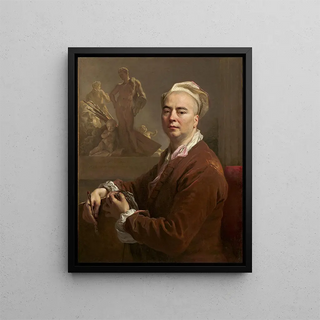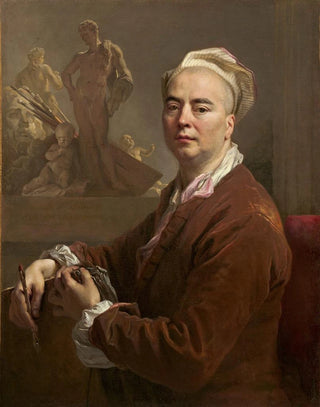Art print | Self-portrait - Nicolas de Largillière


View from behind

Frame (optional)
Nicolas de Largillière's Self-portrait is an iconic artwork that embodies the spirit of the 18th century, a time when art became a reflection of individuality and social status. This painting, vibrant with colors and nuances, invites us to delve into the universe of the painter, an artist whose talent captured the essence of his era. Confronted with his gaze, we are transported to a period where art does not merely adorn walls but tells stories, lives, and aspirations. The art print of this piece allows us to relive this aesthetic experience and rediscover the importance of the self-portrait in art history.
Style and uniqueness of the work
Largillière's Self-portrait stands out for its refined technique and meticulous attention to detail. The play of light and shadow, characteristic of the baroque style, gives the work a striking depth. The colors, both rich and delicate, blend harmoniously, creating an atmosphere that is both intimate and solemn. The artist, portraying himself with such mastery, highlights not only his technical skill but also his role as a creator of images and meanings. The choice of clothing and accessories, carefully selected, reflects his social status and position. This painting is not merely a self-representation but a declaration of identity, an artistic manifesto that still resonates today.
The artist and his influence
Nicolas de Largillière, born in 1656, is one of the great masters of French portraiture. His career, marked by numerous commissions from high society, allowed him to explore the subtleties of human psychology through his subjects. His influence extends well beyond his time, inspiring many artists who followed in his footsteps. Largillière successfully combined tradition and innovation, integrating elements of the Flemish style while developing a distinctly French approach. His works, often imbued with great sensitivity, testify to an era when art was a powerful means of communication, and his self-portrait is a perfect illustration of this. In harmony with the concerns

Matte finish

View from behind

Frame (optional)
Nicolas de Largillière's Self-portrait is an iconic artwork that embodies the spirit of the 18th century, a time when art became a reflection of individuality and social status. This painting, vibrant with colors and nuances, invites us to delve into the universe of the painter, an artist whose talent captured the essence of his era. Confronted with his gaze, we are transported to a period where art does not merely adorn walls but tells stories, lives, and aspirations. The art print of this piece allows us to relive this aesthetic experience and rediscover the importance of the self-portrait in art history.
Style and uniqueness of the work
Largillière's Self-portrait stands out for its refined technique and meticulous attention to detail. The play of light and shadow, characteristic of the baroque style, gives the work a striking depth. The colors, both rich and delicate, blend harmoniously, creating an atmosphere that is both intimate and solemn. The artist, portraying himself with such mastery, highlights not only his technical skill but also his role as a creator of images and meanings. The choice of clothing and accessories, carefully selected, reflects his social status and position. This painting is not merely a self-representation but a declaration of identity, an artistic manifesto that still resonates today.
The artist and his influence
Nicolas de Largillière, born in 1656, is one of the great masters of French portraiture. His career, marked by numerous commissions from high society, allowed him to explore the subtleties of human psychology through his subjects. His influence extends well beyond his time, inspiring many artists who followed in his footsteps. Largillière successfully combined tradition and innovation, integrating elements of the Flemish style while developing a distinctly French approach. His works, often imbued with great sensitivity, testify to an era when art was a powerful means of communication, and his self-portrait is a perfect illustration of this. In harmony with the concerns






